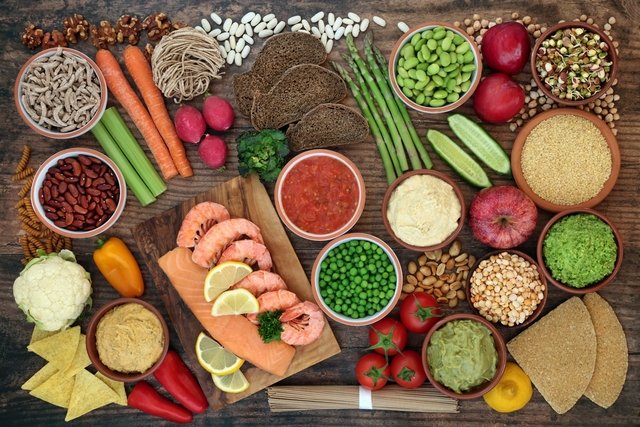The diabetic diet helps control blood glucose levels, preventing an excess or excessive drop in blood sugar. A diabetic’s blood sugar imbalance can generate symptoms such as dizziness, weakness, headache and, in more serious cases, can cause blindness, kidney or heart disease.
Therefore, during the diet it is important to increase your intake of foods rich in fiber, as they help control blood glucose levels. Just as you should consume foods with a low glycemic index, which are slowly absorbed by the body, balancing blood sugar levels. See a list of foods with a low glycemic index.
Therefore, once diabetes is diagnosed, it is important to consult a nutritionist to carry out a complete nutritional assessment and develop a nutritional plan suited to individual needs.

Foods that can be consumed
The top 20 foods that diabetics can consume are:
- Bean;
- Chickpea;
- Tofu;
- Litter;
- Pera;
- Tangerine;
- Strawberry;
- Vegetables: lettuce, broccoli, zucchini, tomatoes, spinach, cauliflower, eggplant and carrots;
- Oat;
- Corn;
- Integral rice;
- Chicken;
- Fishes and sea food;
- Eggs;
- Seeds, such as sunflower, flaxseed, chia, pumpkin;
- Cashew nut;
- Brazil nuts;
- Drinks: water, teas and unsweetened coffee;
- Skimmed milk and yogurt;
- Minas cheese.
The ideal is to always eat small portions of food every 3 hours, having 3 main meals and 2 to 3 snacks per day (mid-morning, mid-afternoon and before bed), and meal times must be respected . See what a diabetes diet should be like.
What to eat in moderation
Foods that should be consumed in moderation in diabetes are:
- Brown rice, whole grain bread, couscous, cassava flour, popcorn, peas, corn flour, potatoes, pumpkin, cassava, yams, sweet potatoes, beets and turnips;
- Some fresh fruits, such as melon, papaya, jackfruit, persimmon, custard apple and grapes;
- Wholemeal pancakes prepared at home;
- Red meat;
- Sweeteners, such as sodium saccharin, sucralose and aspartame;
- Olive oil, flaxseed oil, avocado oil and coconut oil;
- Semi-skimmed milk and yogurt.
In addition to these, dark chocolate, preferably with 80% or more cocoa, is also allowed in diabetes, but should be consumed in moderation according to the nutritionist’s guidance.
Foods that should be avoided
The top 20 foods diabetics should avoid are:
- White rice;
- puff pastry;
- Cakes;
- White breads;
- Cookies;
- Soft drinks;
- Fruits in syrup;
- Jams;
- Fruit juices;
- Dried fruits: dates, figs, apricots, raisins and plums;
- Mortadella;
- Ham;
- Sausage
- Sugar;
- Mel;
- Ice creams;
- Milk chocolate;
- Fried food;
- Alcoholic beverages;
- Full-fat dairy products: yellow cheeses, whole milk, full-fat yogurt, cream cheese and cream.
These foods contain a large amount of fat and/or sugar, interfering with the concentration of glucose in the blood.
Can you eat sweets with diabetes?
It is important to avoid eating sweets in diabetes, as they contain large amounts of sugar that increase blood glucose levels, increasing the risk of complications associated with diabetes, such as blindness, diabetic foot and infections, for example. Learn about all the complications of diabetes.
However, when you maintain a balanced diet and your blood sugar is controlled, you can occasionally consume some sweets that are preferably prepared at home.
How to control diabetes
To control diabetes, it is recommended to consume foods rich in fiber at every meal, taking at least 25 to 30 grams per day. In addition, you should prioritize foods with a low and medium glycemic index, which will help control blood glucose levels.
It is also important to practice physical activity regularly, such as walking, dancing or weight training, for between 30 and 60 minutes a day, as this also helps regulate blood sugar levels. See other tips for controlling diabetes.
In addition, you should measure the amount of sugar in your blood daily and use the medications recommended by your doctor. It is also important to consult a nutritionist to create an appropriate eating plan.
Bibliography
- EVERT Alison; DENNISON Michelle et al. Nutrition Therapy for Adults With Diabetes or Prediabetes: A Consensus Report. American Diabetes Association. 42. 5; 731-754, 2019
- JAFARIRAD Sima et al. Dark Chocolate Effect on Serum Adiponectin, Biochemical and Inflammatory Parameters in Diabetic Patients: A Randomized Clinical Trial. International Journal of Preventive Medicine. 9. 1; 1-6, 2018
- BRAZILIAN DIABETES SOCIETY. Nutrition Manual: people with Diabetes. 2009. Available at: <https://www.diabetes.org.br/publico/pdf/manual-nutricao-publico.pdf>. Accessed on November 14, 2019
- THE UNIVERSITY OF SIDNEY. Glycemic Index. Available at: <http://www.glycemicindex.com/foodSearch.php>. Accessed on Aug 9, 2019

Sign up for our newsletter and stay up to date with exclusive news
that can transform your routine!
Warning: Undefined array key "title" in /home/storelat/public_html/wp-content/plugins/link-whisper-premium/templates/frontend/related-posts.php on line 12
Warning: Undefined array key "title_tag" in /home/storelat/public_html/wp-content/plugins/link-whisper-premium/templates/frontend/related-posts.php on line 13




